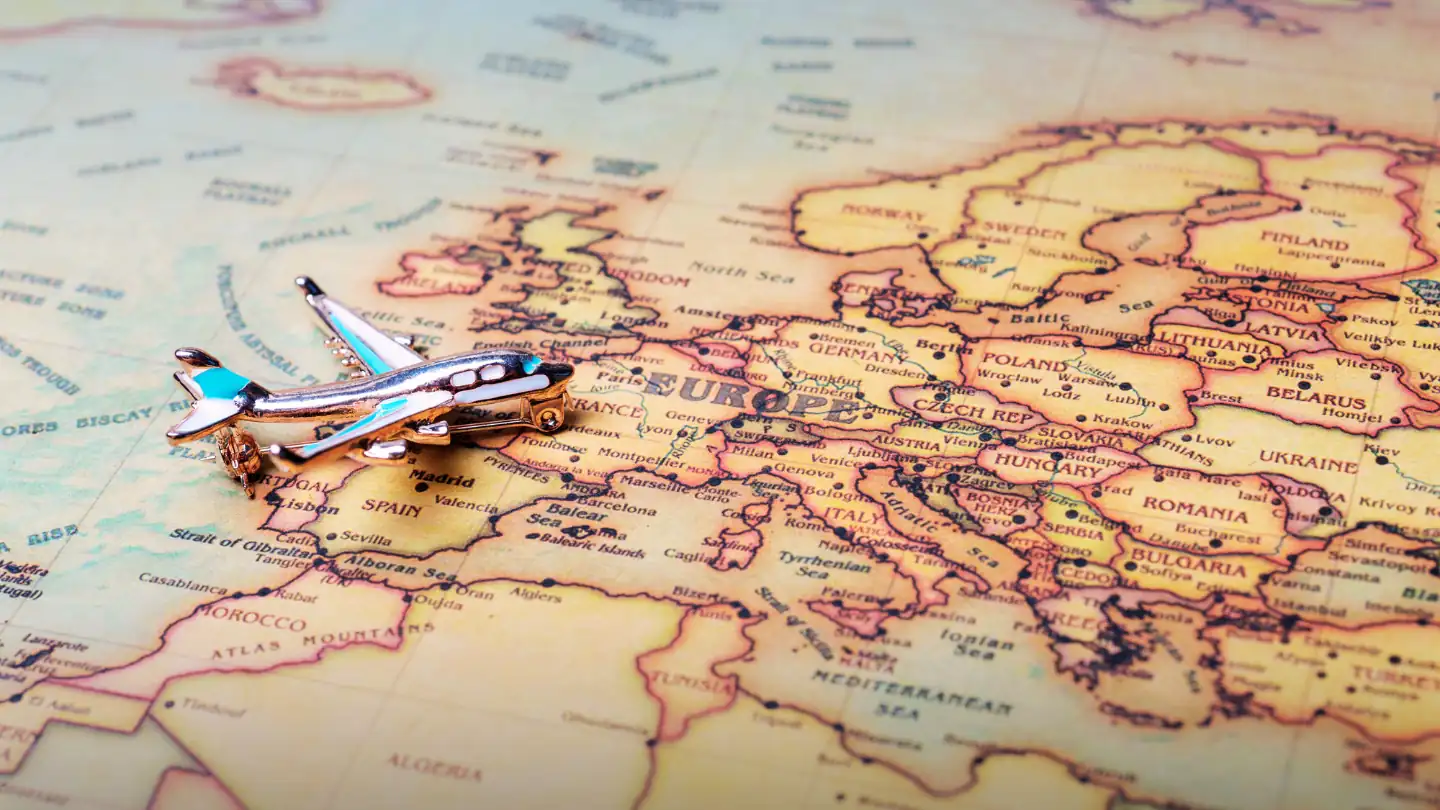Planning a multi-country itinerary across Europe opens the door to some of the most memorable travel experiences. From the cobbled streets of Prague to the sunlit canals of Venice, every destination feels like a storybook come alive.
European countries are the world’s tourism hotspots. Statista notes that five of the top 8 most visited countries in 2024 are in Europe. France and Spain were the top two most visited, followed by the US. European countries account for more than 50% of international travelers worldwide.
But exploring several countries on a single trip can feel overwhelming if your planning isn’t well thought out. A smooth experience comes from organizing your journey to balance sightseeing, travel time, and rest.
Table of Contents
Understanding Your Travel Goals
The first step to crafting a relaxed multi-country itinerary is to understand what you truly want out of your trip. Some travelers prefer to explore major capitals like Paris, Berlin, and Rome, while others enjoy discovering smaller towns that capture the local charm.
Conde Nast Traveller has created a must-visit bucket list of 13 trips in Europe. Some of the trips include:
- Exploring Porto
- Slow travel in Lake Garda
- Island hopping in Greece
- Road trip through Ireland
- Exploring Norway
- Croatia’s untouched islands
- Visiting Iceland’s Westfjords
Setting a clear purpose helps you decide how long to spend in each destination and which routes make sense. Think about whether your trip is focused on art, food, history, or scenic beauty, and shape your route accordingly.
When you plan across several borders, consider the time needed for transportation and the kind of travel pace that suits you best. Europe’s train network is fast and efficient, but connections can vary between regions. Avoid rushing through too many places.
Preparing for a Smooth Journey
Organize essential documents early, be it your passport, visas, and travel confirmations. While checking your bookings and connections, take a moment to think about your safety and well-being. A survey by the European Travel Commission found that travelers cite Europe as the safest region worldwide.
Its political stability, personal security, and lower risks of terrorism make it an ideal destination for travelers. Therefore, 38% of international travelers surveyed planned a trip to Europe. Of them, 73% planned multi-country trips.
However, unexpected events may still arise. Unexpected events like missed trains, weather disruptions, or minor injuries can happen anywhere. Consider the example of an accident. A BBC article mentions a Lisbon carriage accident that killed at least 16 and injured more than 20. Similarly, a CNN News article states that overtourism is causing more car crashes in Scotland.
In such a situation, travel accident insurance can be beneficial. According to LIFE143, it can cover the financial expenses arising from injuries sustained in an accident while traveling. This is not like any traditional insurance that covers missed trips or lost luggage.
Instead, travel accident insurance is specifically designed for medical costs related to injuries. It helps you avoid stress and extra costs if any problems arise during your trip.
Managing Budget Without Compromising Comfort
Multi-country trips can become expensive if you don’t track your spending early on. Setting a daily budget for food, transport, and accommodation keeps your finances predictable.
Research average costs in each country since prices can vary widely between Western and Eastern Europe. Pre-booking major train journeys and long-distance buses often helps you save money while ensuring a smoother travel schedule.
Choosing where to splurge and where to save can make a big difference. You might prefer affordable stays in smaller towns so you can enjoy a fine dining experience or a cultural show in a capital city.
Using local markets for meals or staying in boutique guesthouses gives a more authentic experience without stretching your wallet. You can also plan a route that includes some cheap European countries along with the popular destinations.
According to Euronews, some of the cheapest countries in Europe are Turkey, Bulgaria, Romania, Montenegro, and Serbia. On the other hand, some of the most expensive ones include Switzerland, Iceland, Luxembourg, Denmark, and Ireland. Mixing these countries would ensure that you can experience both standard and luxury travel in a single trip.

Balancing Activity and Rest
One of the biggest mistakes in multi-country travel is overpacking your schedule. Every country in Europe offers more than enough attractions to fill several days. Allow downtime between sightseeing days.
Traveling without a fixed schedule often brings the best moments, like meeting locals or stumbling upon a small street show. A traveler wrote a Business Insider article to share the biggest mistakes she would rectify when traveling to Europe on her next trip.
One of the five mistakes she listed was overplanning her days. She notes that you should not feel constantly stressed about making it to the next activity. You should also have some unplanned time or days, where you can simply stroll on the streets and do whatever you want.
Avoid the temptation to see “everything.” A well-paced itinerary leaves room for rest, reflection, and the joy of slow travel. The purpose of your journey isn’t to collect stamps in your passport, but to feel connected to the places you visit.
Frequently Asked Questions
Q: What’s the best time of year to travel across multiple European countries?
A: Spring (April to June) and autumn (September to early November) are great times to explore several European countries. The weather is comfortable, crowds are smaller, and prices are usually lower than during summer. Winter can be wonderful for festive markets and skiing, but shorter days and unpredictable weather may affect travel plans.
Q: How far in advance should I start planning my itinerary?
A: Start planning at least three to four months before your departure, especially if you’ll be visiting during busy months. This allows time to compare flight options, research visa rules, and find good accommodation deals. Early planning also helps secure popular routes and local experiences that often sell out.
Q: Do I need a visa for every country in Europe I visit?
A: Not necessarily. There’s a Schengen Area in the European region. The countries that are a part of this allow visa-free travel for a set duration. However, some countries, like the UK, Ireland, or certain Balkan nations, have separate entry rules. Check the visa rules for your nationality before making any travel bookings.
As your departure approaches, double-check your travel documents, reservations, and currency needs. Try to plan one or two flexible days in your itinerary to adjust for weather or mood. Remember that the number of cities visited doesn’t measure a successful European trip, but rather how much you truly enjoy each one.
The art of stress-free travel lies in thoughtful planning, realistic expectations, and a sense of curiosity. Europe’s diversity means every border crossing brings new flavors, languages, and traditions. With careful preparation, balanced pacing, and a bit of spontaneity, you’ll create a trip that feels smooth, safe, and deeply memorable.
Q: How many days do I need for a multi-country itinerary in Europe?
A: A typical multi-country itinerary in Europe works best with 10–14 days, allowing enough time to explore at least three major destinations without rushing. If you plan to visit four or more countries, consider extending your trip to 2–3 weeks to avoid spending too much time in transit. Shorter trips are still possible, but choosing nearby countries or cities connected by high-speed trains is essential.
Q: How do I choose which countries to include in my multi-country itinerary?
A: Start by grouping countries that are geographically close or well-connected by trains and budget airlines. For example, France–Belgium–Netherlands or Italy–Austria–Switzerland make efficient routes. Your multi-country itinerary should be based on travel goals—culture, food, nature, or history—and the time you have. Prioritizing your must-see destinations helps prevent overcrowding your schedule.
Q: What’s the best way to travel between countries on a multi-country itinerary?
A: Europe offers several convenient options: high-speed trains, budget airlines, and long-distance buses. For shorter distances, trains are usually faster and more scenic. For longer stretches, flights may save time. A good multi-country itinerary usually combines different transport modes depending on cost, time, and convenience.









